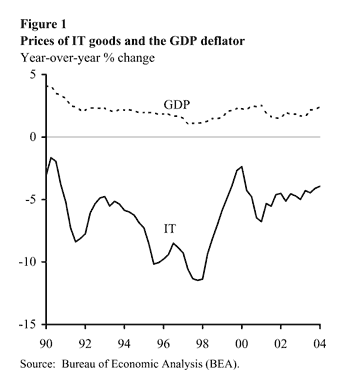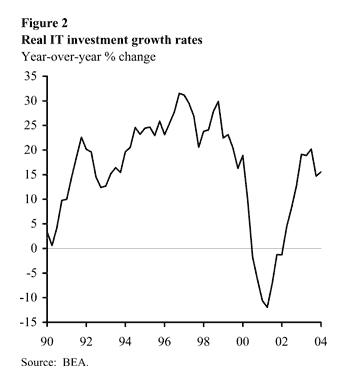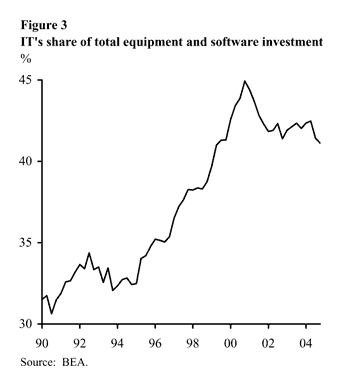Investment in information technology (IT)—that is, business spending on computers, communications equipment, and software—has featured prominently in the ups and downs of U.S. economic growth over the last decade. In the late 1990s, double-digit growth in IT investment contributed significantly to high GDP and productivity growth rates. And in 2001, the sharp contraction in IT investment helped lead the economy into recession.
- Falling IT prices and “real” vs. nominal IT investment
- Will IT prices continue to fall?
- The changing response to falling IT prices
- Summary
- References
|
Investment in information technology (IT)—that is, business spending on computers, communications equipment, and software—has featured prominently in the ups and downs of U.S. economic growth over the last decade. In the late 1990s, double-digit growth in IT investment contributed significantly to high GDP and productivity growth rates. And in 2001, the sharp contraction in IT investment helped lead the economy into recession.
While the growth in IT investment has picked up during the recovery and expansion, it has not regained the very rapid pace of the glory days of the late 1990s. Will those glory days ever return? In exploring this question, this Economic Letter looks at one of the main drivers behind the earlier strength in IT investment—the falling prices of IT goods, which themselves were brought about by rapid technological advances in the field. The good news is that some evidence suggests that continued advances should help real IT investment achieve rates of growth that exceed the growth in other investment goods; however, at the same time, there are reasons to think that growth in IT investment is likely to be more subdued than in the late 1990s.
 Falling IT prices and “real” vs. nominal IT investment
Falling IT prices and “real” vs. nominal IT investment
While many factors may affect IT investment, Doms (2004) has identified the falling prices of IT goods as a major driver in the IT investment surge of the late 1990s. As Figure 1 shows, the prices of IT goods have fallen extremely quickly, while the prices of other goods (represented by the GDP deflator, a measure of general price inflation) have risen modestly. For example, according to official statistics, businesses would have needed to spend $1,963 on IT goods in 1995 for what they could have purchased for $1,000 in 2004 (and there are reasons that this figure is understated), implying that prices of IT goods fell at an average annual rate of 7.4%.
Real IT investment is the amount of money spent on IT goods adjusted for the prices of IT goods. Thus, given the falling IT prices, the differences in the growth rates for nominal and real IT investment can be large; in fact, real IT investment can be rising while nominal IT investment is falling. Therefore, when discussing how strongly IT investment is growing, it is important to delineate clearly between nominal and real investment. Although the business community, especially those firms that produce and sell IT goods, tends to focus on nominal investment, that is, how much money is actually being spent, the relevant consideration for real GDP growth is real investment in IT.
 Figure 2 shows that growth in real IT investment was especially strong between 1995 and 2000, averaging 24% per year and adding an annual average of over 0.8 percentage point to the growth in real GDP. Real IT investment contracted sharply in 2001, falling nearly 11%. Since then, real IT investment has picked back up—for instance, in 2004 real IT investment grew 15.6 percent, contributing 1/2 percentage point to GDP growth—but it has not returned to the phenomenally high growth rates of the late 1990s.
Figure 2 shows that growth in real IT investment was especially strong between 1995 and 2000, averaging 24% per year and adding an annual average of over 0.8 percentage point to the growth in real GDP. Real IT investment contracted sharply in 2001, falling nearly 11%. Since then, real IT investment has picked back up—for instance, in 2004 real IT investment grew 15.6 percent, contributing 1/2 percentage point to GDP growth—but it has not returned to the phenomenally high growth rates of the late 1990s.
Will IT prices continue to fall?
Prices for IT goods reflect both improvements in the quality of those goods and the combined effects of the supply of and the demand for them. The price declines for IT goods witnessed over the decades have been largely driven by sharp increases in supply, which reflect, in part, the tremendous leaps in IT technology. Looking ahead then, what happens to prices of IT goods will depend on the pace of technological innovation. Although forecasting technological innovation is difficult and fraught with peril, there is evidence on spending for research and development (R&D) that suggests some promise for a reasonably rapid pace of technological progress in that field going forward.
In 2002 (the most recent official data from the National Science Foundation), R&D in the computer and software industries totaled over $46 billion, making up almost one-fourth of all private sector R&D, which is near the same level as in the late 1990s and into 2000. This large sum of R&D spending is likely to produce innovations that will result in falling IT prices and an increase in the amount of IT goods demanded by businesses.
Take, for example, the effect of R&D spending on semiconductors. Research has shown that advances in the design and production of semiconductors have played an important role in the price declines of computers and communications equipment. One aspect of the technological advances in semiconductors is the size of individual chip components. Over time, these components (that is, individual transistors) have become smaller and smaller; the smaller the components, the more chips that can be etched onto a wafer, the greater the number of components per chip, and also the faster those chips are able to run. The International Technology Roadmap for Semiconductors (ITRS) (2004) noted that the shrinking of the size of the components on microprocessors and dynamic random access memory chips accelerated in the second half of the 1990s, the period when prices for IT goods also fell very rapidly. Using the terminology of the ITRS, the “technology node cycle”—a rough measure for the length of time it takes for components to shrink by 50%—shifted from three years to two years in the late 1990s and remained at two years through 2003.
Looking ahead, the ITRS expects the technology node cycle to revert back to three years, a pace that is still very rapid. The continued shrinking of components should allow for further declines in the cost of producing chips and also allow new and better chips to be designed, both of which will result in falling prices.
The changing response to falling IT prices
Although the future of innovation appears fairly bright for IT goods, there remains a question of how nominal IT investment will respond to lower prices (recall that real investment depends on nominal investment and prices). This response to price changes is called the “elasticity” of demand. The demand for a good is more elastic if people are willing to increase their spending on it by more than the amount by which the price of the good has fallen.
 Business demand for IT goods during the 1990s appeared to be very elastic; prices for IT goods fell and nominal spending on IT goods surged; indeed, it surged faster than spending on other investment goods. Because nominal spending on IT grew so quickly, the share of total investment spending going to IT goods increased rapidly during the 1990s, as shown in Figure 3. In 1990, nominal investment in IT goods totaled $132 billion, a bit less than one-third of private nonresidential equipment and software investment (E&S). By 2000, IT investment stood at $402 billion and its share of E&S investment peaked at 44%, the height of the high-tech bubble. Since then, the IT share has drifted down, reaching 41% by the end of 2004.
Business demand for IT goods during the 1990s appeared to be very elastic; prices for IT goods fell and nominal spending on IT goods surged; indeed, it surged faster than spending on other investment goods. Because nominal spending on IT grew so quickly, the share of total investment spending going to IT goods increased rapidly during the 1990s, as shown in Figure 3. In 1990, nominal investment in IT goods totaled $132 billion, a bit less than one-third of private nonresidential equipment and software investment (E&S). By 2000, IT investment stood at $402 billion and its share of E&S investment peaked at 44%, the height of the high-tech bubble. Since then, the IT share has drifted down, reaching 41% by the end of 2004.
The drop in IT’s share of E&S investment since 2000 could be preliminary evidence that the demand elasticity for IT investment goods has diminished, that is, that future nominal demand will be less responsive to lower prices than it was in the past. Why would the elasticity change over time? One reason is that the IT sector has matured. During the 1990s, there was a tremendous buildout of new computer and communication networks and the initial adoption of many software programs. Relative to the 1990s, the rate of diffusion of IT has certainly slowed, damping investment. Now when IT products are introduced, firms respond by upgrading their existing IT technology, but the boost from firms delving into IT has likely been lost.
Summary
Technological progress in the IT area will likely continue to lower the prices of IT goods, which in turn helps boost IT spending. However, as the IT industry has matured, the response of business spending on IT goods for a given change in prices may have become more muted recently, suggesting that nominal spending on IT goods may not increase as quickly as it did in the late 1990s. Consequently, real spending may also grow at historically modest rates, though strong relative to other investment goods whose prices do not fall as fast.
Mark Doms
Senior Economist
Doms, Mark. 2004. “The Boom and the Bust in Information Technology Investment.” FRBSF Economic Review 2004, pp. 19-34.
/economic-research/review/2004/er19-34bk.pdf
International Technology Roadmap for Semiconductors. 2004. 2004 Update: Overview and Summaries.
http://www.itrs.net/Common/2004Update/2004Update.htm
Opinions expressed in FRBSF Economic Letter do not necessarily reflect the views of the management of the Federal Reserve Bank of San Francisco or of the Board of Governors of the Federal Reserve System. This publication is edited by Anita Todd and Karen Barnes. Permission to reprint portions of articles or whole articles must be obtained in writing. Please send editorial comments and requests for reprint permission to research.library@sf.frb.org